| Soft Centre 1 |
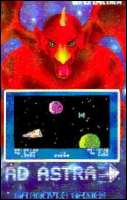
BEFORE you groan and shout "Not another space wars game", wait a moment. Ad Astra is a little out of the ordinary. Gargoyle Games clearly has put plenty of thought into this nightmare of inter-stellar mayhem. You are piloting a patrol craft through deep space, on the look-out for pirates and hostile aliens. That sounds familiar enough but the accompanying graphics put the first Gargoyle offering into a class of its own.
For a start, the pictures are very big. The game opens with a series of planets between which you must weave to reach open space; as they hurtle towards you they seem to fill the screen.
The 3-D effects extend even to your laser fire, which curls and splutters about the screen as you hurtle from side to side. The action is fast and furious and you can pilot your craft in any of eight directions.
At first, the sheer size of your ship is a problem. It seems impossible to avoid being trapped in the corner by a hail of missiles.
Ad Astra is a very welcome addition to the plethora of space games and on the strength of this Gargoyle is clearly a team to watch.
| AD ASTRA | Memory: 48K | Price: £5.95 | Joystick: Kempston, Cursor type, Interface II | Gilbert Factor: 8 |
IN AN ADVENTURE game, death usually results from carelessness, bad planning and timing or merely an excess of the gung-ho mentality. It can then become exasperating when all your careful work is erased at a stroke because an arcade section has been included which requires only manual dexterity as a survival skill.
The Atlas Assignment, written by Martyn Davis, author of The Island, is such a program, in the main following a pure text format but studded with a trio of arcade action sequences. There will no doubt be many players who enjoy those facets of the game as much as the puzzle-solving in the rest of it.
The full machine code game casts the player as a secret agent in pursuit of Atlas, a formidable spy who has somehow lifted the American nuclear defence plans and intends to sell them. The adventure will take you globetrotting and, to be fair, the arcade portions are billed as shoot-outs. The remainder of the game follows a classic adventure pattern and a great deal of ingenuity and thought is required even to reach the first sudden death exercise.
You will need some understanding of map-work, sociability to obtain information, and plenty of time to figure it out. All the usual adventure facilities and commands are included, though it is not the complex kind of adventure in which speech is possible. Most of the characters are passive and do not interact in Hobbit or Valhalla style. If the test of an adventure is that you have to keep trying, The Atlas Assignment from Virgin Games will suit you.
| ATLAS ASSIGNMENT | Memory: 48K | Price: £5.95 | Gilbert Factor: 7 |
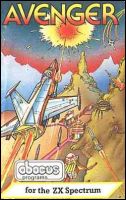
THERE ARE many variants of the classic arcade games available and it would take a game with considerable originality to cause any real excitement. Avenger from Abacus for any Spectrum is not one of them, using the Scramble format as its setting and the destruction of a presumably highly evil extra-terrestrial civilisation as its purpose.
The alien planet is mountainous and littered with supply bases, missile sites, atomic reactors and interceptor launch pads. Along that landscape you must manoeuvre your ship, protected by its five shields, and blow the aliens away before they succeed in blowing you away.
The ship is supplied with laser and bombs. There are five levels of difficulty, though the tasks remain the same, and movement is keyboard-based, with no joystick option. Action is two-dimensional and, though the machine code graphics are generally competent, the ship moves along rather jerkily.
The aliens are swift and deadly in a reasonably tough arcade clone but perhaps we may soon have games where humans will need to use intelligence and subtlety in peaceful dealings with other beings.
| AVENGER | Memory: Any Spectrum | Price: £5.95 | Gilbert Factor: 5 |
BASIC UTILITIES is the first product of a new software company, Jaysoft. It is a collection of five routines for the 16K and 48K Spectrum. The code, 3,856 bytes, stored at the top of memory is called by a RAND USR when needed, at which point you are presented with a menu. It will also work with a Microdrive attached.
The routines are REM FILL, a routine which creates a REM at line 0 of any length or adds to it if it already exists. If line 0 is not a REM, no change is made. VARDUMP lists the current state of all the variables. BLOCK DELETE deletes a specified block of lines. RENUMBER works on GO TO, GO SUB, RESTORE, LIST, RUN and LINE.
TELESCOPE can shorten a Basic program in three ways - by deleting all REM lines, substituting variables for commonly-used line numbers, and by making separate lines into multi-statement ones. Each line is stepped through and Y or N is pressed to join it on to the previous one.
The program is slightly over-priced considering the other available programs on the market but is, nevertheless, a very useful collection.
| BASIC UTILITIES | Memory: 16K | Price: £5.95 | Gilbert Factor: 6 |
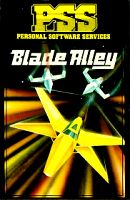
STAR WARS appears to have been the main inspiration behind Blade Alley, in which you must fly your ion-driven interceptor along a defensive trench while avoiding or firing at the enemy craft hurtling towards you.
The three-dimensional effects and perspective of the game are realistic, with shadows under each craft adding that extra touch of sophistication, and the player's fighter vessel handles well on either the keyboard or joystick.
You have three lives to enable you to notch a score which might take you from the rank of space cadet to leader and eventually admiral.
The enemy craft prove difficult to hit and although it is possible to stay in the game by weaving your way between them, achieving an impressive score is a laborious and possibly discouraging task.
The game offers six screens, with varying backgrounds and additional hazards such as hopping aliens to increase the player's difficulties.
Blade Alley is produced by PSS, Coventry.
| BLADE ALLEY | Memory: 48K | Price: £6.95 | Joystick: Kempston | Gilbert Factor: 6 |
BYTE is an adventure game with a difference, according to CCS, which produced this offering. You play the role of a computer and move round a simple grid of rooms hunting for various circuits. There are seven levels of difficulty and you have statistics based on RAM, languages known, speed of operation and the like.
So far, so good, although the heavy-handed jocularity of it all raises more groans than laughs after a time, but there are other reasons why Byte is 'an adventure game with a difference'. For a start, it must rank as one of the slowest adventures written. It seems to be programmed almost entirely in Basic and the response time consequently is poor. Second, the program insists on going through a series of routines every time you type-in a command, including an uninspired jingle, a listing of your character statistics, and a statement of what you can see. That all takes time, slowing the game to a truly awesome crawl.
The descriptions of rooms and their contents have a wonderful simplicity. They go something like this. 'You are in room 3,1 on level 1. You can see: Ark.' You then type in your command, such as 'o' for open or 'w' for west. The computer thinks about your letter, tells you what it means, and finally does something about it.
With all that and no graphics, CCS seems to have taken a perverse step backwards with its game. It lacks even the more basic elements of old-fashioned text-only adventures. The result is unlikely to be of use to anyone, except possibly as a cure for insomnia.
| BYTE | Memory: 48K | Price: £6.00 | Gilbert Factor: 3 |
FANCY YOURSELF as a good mouser? If so, sharpen your computerised claws and get into the larder - the family has a plague of hungry mice and if you cannot move Caesar the Cat round the screen fast enough there will be no more fish for you.
Caesar is the guardian of four shelves of assorted food and its aim is not only to catch as many ravenous rodents as possible but also to beat the score clock counting down to zero at high speed.
Caesar must take the mice out of the larder door for the score to register. Easy? Not really, as there are jars around which, if knocked over, will reduce the score still further. There are three waves of mice. Items will disappear from the cupboard as the mice munch at them. Catch the full 30 and stores will be replenished - but only to attract more mice.
Caesar can be moved with convenient keys or there is a Kempston joystick option. The graphics are clear and in colourful cartoon style which may appeal to younger age groups. The game, from Mirrorsoft, is nevertheless likely to attract all the family.
| CAESAR THE CAT | Memory: 48K | Price: £8.95 | Joystick: Kempston | Gilbert Factor: 7 |
ATTENTION all battle-weary adventurers. Once again the call has gone out for a real live hero to investigate the traps and treasure, monsters and magic of some dank, perversely unmappable castle in a forgotten corner of Fantasyland.
One ought to yawn, turn the lamp low, put out the griffin and go to bed, but for aficionados of secret chambers hedged about by impenetrable logic puzzles the delights of playing the game seemingly never flag.
If you were bored by the last fantasy adventure you played, Castle Blackstar is unlikely to excite you wildly. That said, the SCR team has produced a competent text-only adventure.
The computer accepts most of the usual commands and has a 200-word vocabulary.
A modest prize is offered to the first few adventurers to reach the bitter end and return the Orb of Artemis to its rightful place.
One welcome feature is the ease of movement round the castle and its environs. Andrew Cummins of SCR says most of the problems are accessible independently of each other, so there is no need to spend days beating your brains out on one problem before you proceed to the next.
The program is apparently the first in a series of related quests. It remains to be seen whether players have the stamina to keep up with the series but Castle Blackstar should keep the peculiar minds of adventure freaks hyperactive for a month or so at least.
| CASTLE BLACKSTAR | Memory: 48K | Price: £8.95 | Gilbert Factor: 7 |
INSTRUCTIONS to games which appear on-screen should be clear and uncluttered, especially if they are there to act as some inducement to play. In Chuckman from Add-on for the 48K Spectrum they are guaranteed to give you a headache if you look at them for too long, as the densely-worded page is backed by a multi-coloured checkerboard which flashes and changes about twice a second.
That makes it difficult to absorb them without reaching for the aspirin. Never mind, that is the only criticism of an otherwise excellent program.
The Chuckman is a skateboarding bomb disposal expert who must search the winding paths of a huge maze to find a toolkit. With that he can defuse the ticking time-bomb located somewhere in the labyrinth. That is not his only problem, since he needs to find food to maintain his energy, wheelbarrows of sand to fill the pits which block the way, and roller skates to ward off the giant boots which threaten his progress. A shovel is also handy to hem in the stomping boots.
Instructions apart, Chuckman is a finely-crafted arcade-action program. The pixel graphics are smooth and well-designed, with a fast response to the keyboard commands. There is also a Kempston joystick option. The Chuckman is a quirky little figure who, if you stop moving him, will stand hands on hips and tapping his foot. There are various status indicators beside the main maze screen and a map is provided, though it will show only part of the full labyrinth and will drain energy if used. The game should have very broad appeal.
| CHUCKMAN | Memory: 48K | Price: £5.95 | Joystick: Kempston | Gilbert Factor: 8 |
CLOSE-IN is one of those abstract games where you move round the screen drawing a line behind you, while your opponent does likewise. The object is to avoid colliding with your opponent's or your own trail and to cause your opponent to crash by surrounding him.
The version from Pulsonic offers a bare minimum of graphics - two simple lines generated by the players and a set of five mazes which can be superimposed to provide added difficulty.
That such a simple game should require a 48K machine seems extraordinary, even with five screen configurations and a number of skill levels.
The game can be played by two players or against the computer. Two players will have difficulty manipulating eight directional keys each on the same small keyboard and the solitary player may feel aggrieved by the apparent ability of the Spectrum to start again from a new position in mid-game.
There are better variations on the theme available and if Pulsonic is serious about selling the game, it should consider finding how to use a joystick with it at least.
| CLOSE-IN | Memory: 48K | Price: £2.95 | Gilbert Factor: 4 |

ADVENTURE ADDICTS should find plenty to occupy them in Colditz, a well-constructed game from Phipps Associates. The aim is to escape from the infamous German prisoner-of-war camp and at the same time release an eminent scientist whose knowledge is vital to the allied war effort.
The castle is a complex labyrinth of rooms, courtyards, crypts and tunnels. The adventure is liable to be terminated abruptly at any time by the arrival of guards, falling to your death, or being electrocuted on the wire fence, and there are also a generous number of useful objects to be found such as a glass, a hacksaw and a crowbar.
It is essential to keep track of your movements, as well as what the various objects can achieve, if you are to have any chance of finding the correct escape route and managing to bring out the prisoner.
Colditz features graphics which do not add a great deal to the action but fortunately do not slow it, as each new picture reveals itself quickly and efficiently. There is a HELP command and a SAVE facility if you feel that escaping from Colditz cannot be achieved in one day. TAKE ALL is another useful command enabling you to pick up all the objects found in one place without having to type in the name of each.
Colditz is available from Phipps Associates, Ewell, Surrey.
| COLDITZ | Memory: 48K | Price: £6.95 | Gilbert Factor: 8 |
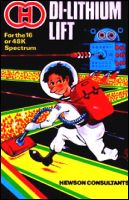
EVEN with the memory limitations of the 16K Spectrum, Di-lithium Lift is a slim offering. The aliens are guarding a vault of Di-lithium crystals, and in this distant relative of Pac-man you have to zig-zag about the screen, picking up crystals while avoiding the lasers of two droids.
The action may be fast but the display employs user-defined graphics rather than true high-resolution programming. The use of sound is rudimentary as well, with standard bleeps and simple scales; even Spectrum owners should expect something more sophisticated than that.
It is possible that Hewson is aiming the game at what is considered to be a younger market. If so, that might excuse the simple concept but not the lack-lustre presentation.
Di-lithium Lift might have been acceptable two years ago and with some advanced graphics programming it might make the grade today. As it is, it is a disappointment.
| DI-LITHIUM LIFT | Memory: 16K | Price: £5.95 | Joystick: Kempston | Gilbert Factor: 3 |
IN THESE DAYS of perspective graphics and complex simulations which tax the mind as well as the joystick fingers, a game like Ed-On, from Add-On Electronics, is a little disappointing.
It is billed as a car racing game in which the player steers his vehicle round a circuit accelerating and decelerating.
The object is to collect the maximum amount of dots while changing lanes to avoid the other car on the circuit. The other machine will do its best to collide with the player's. The circuit is a grid-maze and the vehicles are small UDG symbols. Steering is by the keyboard or you may use a Kempston joystick.
Five lives are allowed in each game. The difficulty increases as you become more successful and more opposing cars will appear after the first screen, making the action tougher and more dangerous - a kind of motorised Pacman, in fact.
It is no state-of-the-art game and the graphic display offers little excitement. The program is fast, however, and the task set is difficult given this speed. At times it seemed as if the computer was cheating, as the enemy car would tend to leap across sections to meet the other.
Steering is easiest with a joystick, though the keyboard controls are simple and well-placed. Manual dexterity and reaction speed are the only qualities needed.
Even if that is all you want from a computer game, there are more interesting games available and it had no really addictive pull to it. All in all, an average program with nothing to raise it above so many others.
| ED-ON | Memory: Any Spectrum | Price: £5.95 | Joystick: Kempston | Gilbert Factor: 4 |
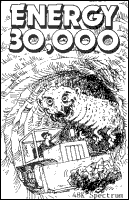
ENERGY 30,000 by Elm Computers for the 48K Spectrum transports you to the year 30000, where uranium stocks are diminishing and you have to collect pink tar - yes, pink - to fuel the reactors.
To help you in the task you have a bulldozer with which to push it. Various nasties try to prevent you doing so and usually succeed.
Part of the program was compiled with the Wye Valley Compiler and it shows. All the graphics are simple UDGs and move in low resolution. It is difficult to tell which parts were not compiled.
If the game is interesting in the first place a compiler is acceptable but in this case it makes a mediocre game into a fast mediocre game.
| ENERGY 30,000 | Memory: 48K | Price: £5.95 | Joystick: Kempston | Gilbert Factor: 3 |